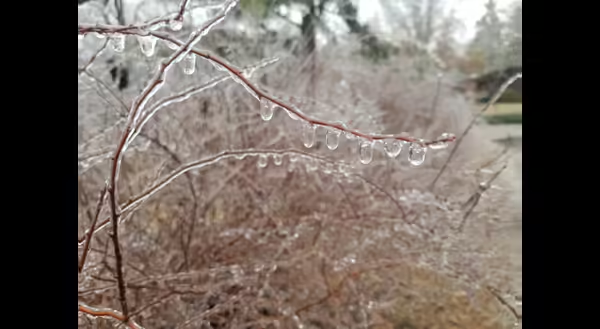
Freezing rain is a regular part of winter weather patterns in central Illinois, resulting in occasional ice storms that can damage property, take out utilities and wreak havoc on tree canopies. By meteorological definition, an ice storm occurs when ice accumulation is greater than 0.25 inches. On average, our area of Illinois experiences about 5 days of freezing rain per year which rarely result in an ice storm, but can nonetheless cause major damage in any instance.
Yesterday’s ice accumulation was fairly significant at my house, although I am not sure if it will reach the level of a true ice storm. We experienced about one tenth of an inch of ice accumulation by 10am and I could already hear the cracking of limbs outside. It appears a large limb near the top or our mature white pine broke out, falling on several other lower limbs to create a mess of frozen foliage and wood on the ground, and a bare spot down one side of the tree.
While yesterday’s ice was certainly damaging, larger ice accumulations (greater than 0.5 inches), can produce heavy damage in trees, especially when combined with wind. So, what can you do to protect your property from ice storm damage?
In order to assess potential property damage from ice storms, it helps to evaluate each large tree in your yard for potential “targets”. Are there power lines under a large tree canopy? Do significant limbs extend out over your home’s roof or the roof of other structures? Do you have high value landscaping under the canopy of a shade tree? If your tree is solitary specimen, with no would-be targets beneath it, perhaps the damage potential to ground level targets is little or none.
Professional arborists are training to assess the structural integrity of trees. These tree experts use the many outward signs a tree provides to identify areas of internal defect and instability before damage occurs. Arborists can often identify limbs with internal cracks and other weaknesses from patterns of bark, wood growth, or branch angle at the trunk. Pruning can remove significant weight from the tips of limbs with weak branch unions (or other defects) to reduce the load upon weak or defective areas in the tree canopy. In combination with pruning, limbs can be cabled or braced to provide addition support for a suspect branch union.
Regular pruning should be part of any plant health care plan, especially for large, high-value shade trees around your property. Pruning will not only keep your tree healthier, but also provides the best available preventative care for any type storm damage, including ice storms.
Wood fiber varies greatly among tree species. Within the field of arboriculture, there is a significant body of research assessing various characteristics of wood fibers among species. We know which tree species have stronger or weaker fibers. We also know which wood fibers tend to bend and which tend to break.
Certain tree species, such as Siberian elm, silver maple, willows and many conifers, are prone to damage from ice storms due to the characteristics of their wood fiber and structure. Professional assessment and pruning to increase structural stability is essential for trees that exhibit high susceptibility to ice storm damage.
It is important to note that evergreens are especially susceptible to ice storm damage simply due to the fact that these trees have a much greater surface area for ice accumulation. Since they bear leaves over the winter months, evergreens have a lot more material for ice to accumulate on when compared to leafless deciduous trees. To further complicate things, many of these species also have more brittle wood fiber, which is inclined to break as opposed to bend. Therefore, it is especially important to assess evergreen trees with significant targets beneath them.
If you experienced damage to trees on your property, reach out to one of our local Certified Arborists. The International Society of Arboriculture maintains an online list of certified arborists at: www.treesaregood.org. An Arborist can assess your tree for structural stability and removed damaged or unsafe limbs. Although broken limbs cannot be repaired, removal of any damaged branches is important for both safety and for your tree’s health.